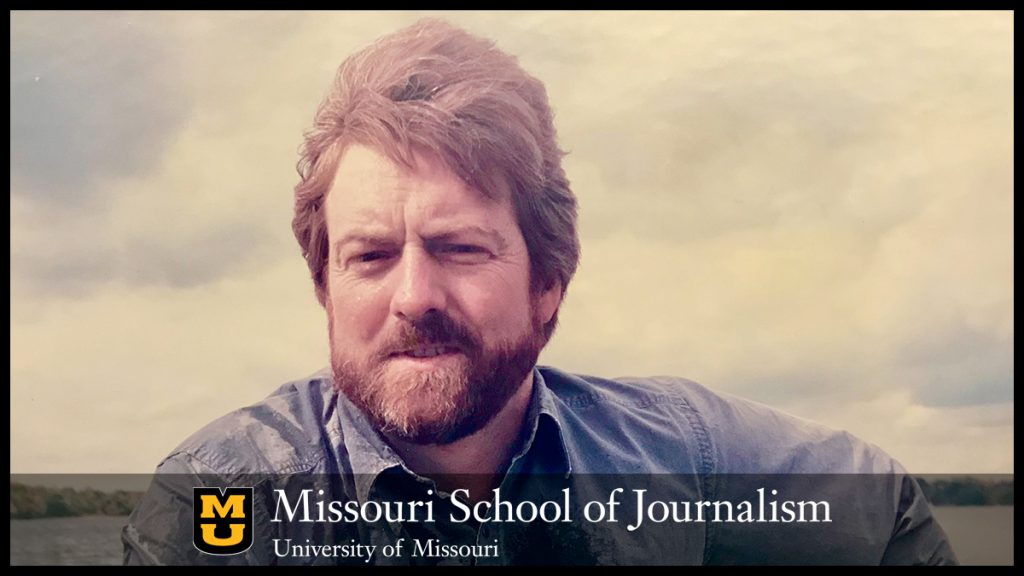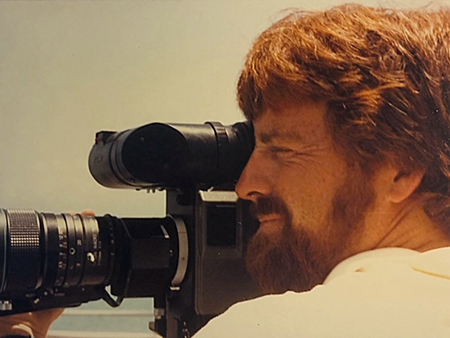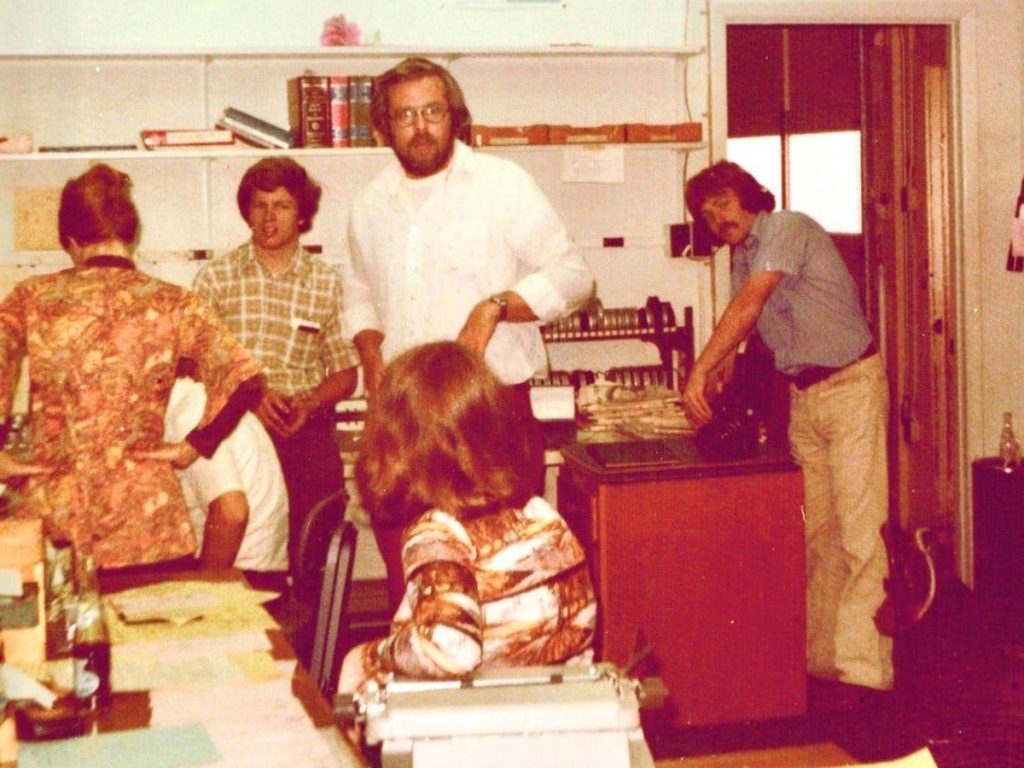Missouri School of Journalism announces Lance Heflin Multimedia Investigative Journalism Scholarship

Photo courtesy Jan Evans
COLUMBIA, Mo. (Jan. 31, 2024) — The Missouri School of Journalism today launched the Lance Heflin Multimedia Investigative Journalism Scholarship, which will support students who are interested in pursuing investigative journalism.
The scholarship honors the late Lance Heflin, BJ ’77, a founding producer of the newsmagazine program “48 Hours” who served for 20 years as executive producer of “America’s Most Wanted” and forged a highly successful career as an investigative journalist and broadcast producer. He also served as the managing editor of KOMU-TV, the School’s NBC affiliate TV station, in the late 1970s while working on his degree.
Initial funding was provided by a gift from Jan Evans, MA ‘80, Heflin’s wife.
“Lance Heflin used his talents and his education to help people throughout his career, and it’s fitting that this scholarship will extend that impact into the next generation of journalists,” said David Kurpius, dean of the School of Journalism. “I’m thankful to Jan for her generosity, which enables the School to help students in his name.”
The scholarship, which is endowed, will provide an annual award in perpetuity — an act that Evans said not only honors Heflin’s journalistic accomplishments but reflects his commitment to helping others find success in their careers.
“He was the kind of guy who stood up for his people,” Evans said. “People stayed with him at ‘America’s Most Wanted’ for years. And if he thought it was time for you to springboard into something else, he would tell you. A lot of people got their starts there.”
That thread of Heflin’s legacy will persist through the scholarship, which will enhance the accessibility of opportunities across all platforms and mediums at the School of Journalism, including investigative and advanced reporting courses, a data journalism sequence, the Target 8 investigative unit at KOMU and many others.
“There is a huge need for more students graduating from journalism schools with investigative reporting skills,” said Mark Horvit, a professor at the School of Journalism who teaches investigative reporting. “There are a growing number of news outlets focused on enterprise and investigative work, and our students are getting jobs in those newsrooms. So a scholarship that will help students pursue that focus area is incredibly helpful.”
Colin Kilpatrick, senior executive director of advancement at the School of Journalism, added that the scholarship also reflects the key role that the School’s alumni and friends play in supporting the future generation of journalists.
“The School continues to be a global leader in journalism education, in large part because of the generosity of our alumni and friends,” Kilpatrick said. “We are grateful to Jan for supporting our talented students and for preserving Lance’s legacy as an esteemed alumnus and investigative reporter.”
America’s Most Wanted

At “America’s Most Wanted,” Heflin was instrumental in bringing a new lead about Elizabeth Smart — then a 14-year-old girl abducted from her home in 2002 — to air after the FBI urged against it and even threatened to end its working relationship with the program. Heflin chose to air the lead anyway, directly leading to her rescue in 2003.
“Two people saw Elizabeth and [her abductor] Brian Mitchell at the same time, and both of them had watched America’s Most Wanted,” said Ed Smart, Elizabeth’s father, in a video message for a celebration of life in Heflin’s honor in 2022. “If it hadn’t been for them doing that, that rescue would not have happened that day.”
Smart was just one of more than 30 missing children reunited with their families during his tenure, along with more than 1,000 fugitives arrested — 17 of whom were on the FBI’s Ten Most Wanted Criminals list.
According to Phil Lerman, a co-executive producer of the show, it was Heflin’s genuine appreciation for the stories the show told that helped make it so successful.
“The way to think about Lance is to think about what it’s like when you’re telling someone a story, and instead of just kind of listening to you while they are waiting to tell you their story, they are actually fascinated,” Lerman said. “Not because they are being nice, but because they really care. That’s what it was like talking to Lance every day. He could never get enough of the story.”
That talent for listening also proved invaluable for mentoring younger journalists. Michelle Sigona, now a producer for “48 Hours” and an analyst on A&E’s “Wanted,” came to “America’s Most Wanted” as an intern in 1999 and worked her way up to become a national correspondent for the show, a journey that she said Heflin supported every step of the way.
When she came to him early in her career with a story about COMTOMS, a government program training first responders to support law enforcement during dangerous operations, he gave her a crucial opportunity to go to Colorado for a week and work with a crew by herself, trusting her to pull it all together.
“The story was important to me as a volunteer firefighter, and I felt it was important to the public and first responders,” Sigona said. “Ultimately, it was important to Lance, too. He believed I could do it. And I did.”
48 Hours and beyond

Outside of “Most Wanted,” Heflin also earned 4 national Emmy Awards at CBS News for his work on “48 Hours” and CBS Evening News. With “Most Wanted” running for 24 seasons and “48 Hours” still on the air today after 36 seasons, Heflin was a crucial part of two of the longest-running programs in television history.
In addition, he co-founded an independent production company, Straight Shooter Productions, in 1995, where he created the internationally syndicated show, “Manhunter,” and the nationally syndicated program, “America’s Most Wanted: Final Justice.”
Fellow “48 Hours” founding producer Cathy Lasiewicz, BJ ’76, recalled how Heflin would keep the mood light on his shoots, whether they were in Alaska in the aftermath of the disastrous Exxon Valdez oil spill or in Cheyenne, Wyoming, at a rodeo.
“Whether it was a cowboy in Cheyenne or the CEO of a big corporation, he knew what to do to tell their story and make them comfortable,” Lasiewicz said. “He could find humor in a difficult situation, which would make everyone relax and do their best work. That was always the end goal for him: helping his team produce its best product.”
The results spoke for themselves.
“Lance was integral in helping establish the visual style of ’48 Hours,’” she added, noting that from the beginning, Heflin understood the program needed to show the story unfolding in front of the viewer. “He not only had an incredible eye and was a great photographer, but he was a talented producer and an amazing writer. He was able to marry the photography and writing to make for incredible storytelling.”
The Mizzou Mafia
Lasiewicz is one of a cadre of School of Journalism alums who tended to cross paths in their professional lives, exemplifying the famed “Mizzou Mafia.” This included Candy Altman, MA ’78, and Joe Bergantino, MA ’80, who Heflin paired up on their first story assignment for KOMU. Heflin, who always had a keen eye, might have seen a different match in the making, as Altman and Bergantino went on to get married. They also ended up working at ABC affiliate WPLG-TV in Miami, where they reunited with Heflin once more. It was at WPLG that, long before his most high-profile roles, Heflin developed a stellar reputation as an investigative journalist willing to go to great lengths for stories that others missed. And it was another alum, Dow Smith, MA ’69, who hired them all.
Working alongside Bergantino, Mark Potter, BJ ’75, and Clarence Jones for the station’s investigative unit, Heflin broke several major stories that made national headlines — and sometimes made headlines himself, as in the spring of 1980, when he was placed under house arrest in Cuba with his reporter and crew and seven other journalists.
1981’s “Human Cargo,” a series of reports about the human cost of an organized criminal enterprise smuggling Haitian immigrants into Miami, was quickly picked up by ABC’s “20/20” and went on to win a duPont-Columbia Award and Robert F. Kennedy Journalism Award. A year later, Heflin would win another pair of RFK and duPont awards with Bergantino and Jones for “The Billion Dollar Ghetto,” accomplishing the rare feat of earning these awards in consecutive years.
Another bombshell story also came in 1982, when Heflin and Potter exposed a drug smuggling operation in Everglades City, a small coastal town on the border of Everglades National Park. The story ended up on “Nightline” and in the pages of The New York Times.
One element of the shoot had to be scrapped at the last minute when their undercover surveillance was scuttled by a late night phone call.
“We got ready to go, and all of a sudden Lance’s phone rang,” Potter said. “I watched his eyes get big — his wife had gone into labor, and we were two hours away across the Everglades. He said, ‘We’ve got to go.’”
Heflin made it to the hospital in time for the birth of his first son, Patrick, just one example of the fact that alongside his relentless pursuit of a good story was a strong sense of loyalty and compassion for his family, friends and colleagues.
It’s a side of him that his high school journalism teacher, Ron Clemons, MA ’65, knows well. During Heflin’s senior year at Truman High School in Independence, Missouri, Clemons lost his wife in a tragic car accident. Soon after, when Clemons returned to the school to brief a substitute teacher, Lance and his twin brother, Vance, BJ ’76, were the first students to appear by his side and offer their support.
“Lance and Vance came running, and what they did for me was marvelous,” Clemons said, recalling that in the days and weeks that followed, the brothers were able to get him to laugh despite the circumstances. “They were beyond their years in knowing how to treat something like that. And I think Lance’s love for people carried him through his career. Every good journalist should really care about people.”
The twins will also be honored together with two memorial benches that will sit near the entrance to Neff Hall on the School’s campus. Vance Heflin, a photojournalist and videographer who also served as a media advisor to Missouri politicians, passed away in 2000. Lance, who passed in 2020, is survived by Evans and their sons Patrick and Walker.
The memorial benches will be installed near a prominent tree just outside Neff’s doors, a visual reminder not just of the impact of Heflin’s work, but of the conviction that his legacy — much like the tree — will continue to grow.
Contributions to the Lance Heflin Multimedia Investigative Journalism Scholarship may be sent to the Missouri School of Journalism Office of Advancement, 103 Neff Hall, Columbia, MO 65211. Please make checks payable to the University of Missouri. For more information, please phone 573-882-0334.
Updated: January 31, 2024